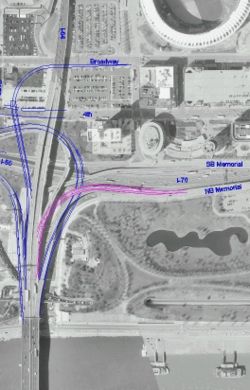Category:104 Scope
 | ||
|
This article covers the initial steps necessary to identify transportation needs, properly scope solutions to those needs and develop commitments prior to inclusion in the Statewide Transportation Improvement Program (STIP). Guidelines are also included for the preparation of appropriate project cost estimates at various milestones and the required documentation of those estimates.
A project's scope can be defined as the set of design parameters that precisely satisfy the purpose and need of the project. A poorly identified scope that is broader than the purpose and need will result in an unnecessarily high project budget and lengthy schedule, while a scope that falls short will yield a project that accomplishes little of significance. Further, a construction program based on poorly scoped projects will eventually fragment, whether by expanding the scope to meet the need during the design process or through field adjustment to correct errors and additional needs during construction.
MoDOT works closely with our customers to identify transportation needs, including those projects that help maintain our transportation systems. MoDOT works with our planning partners to help identify and prioritize the needs in each region. MoDOT then works within the current fiscal constraints to bring these needs forward into the project development process. Typically needs are assigned to Project Managers to establish a purpose and need and set the scope of work. The project manager will then assemble the core team and begin to analyze the need in search of a solution. As development proceeds, more and more aspects of the project will become apparent and the core team, acting through the project manager, will adjust the scope accordingly.
The complete project scoping process involves determining the root causes of the need, developing a range of possible solutions to address the need, choosing the best solution, setting the physical limits of the project, accurately estimating the cost of the project, and forecasting the timeline and delivery schedule of the project. The core team will use available data, meetings, field checks, project safety assessment and public input to accomplish these tasks.
When the appropriate level of confidence in the scope has been reached there is a point of concurrence where the proposed scope is submitted for management concurrence as to whether or not it addresses the original need. The level of concurrence sought is dependent upon the nature and complexity of the project. Right of way and construction funds, as well as the delivery date, will only be publicly committed to a project subsequent to this approval and after having gone through the project prioritization process.
MoDOT also encourages contractor participation in cost-saving techniques. This article contains construction inspection guidance for value engineering involving monetary incentives for contractors.
This article also provides guidelines for completion of scoping, items to be considered and addressed, project scoping checklists, environmental considerations, project scoping documentation and scope changes.
Articles in "104 Scope"
The following 13 pages are in this category, out of 13 total.
1
- 104.1 Core Team
- 104.2 Project Scoping
- 104.3 Timeline
- 104.4 Completion of Scoping
- 104.5 Items to be Considered and Addressed
- 104.6 Project Scoping Checklists
- 104.7 Scoping Estimates
- 104.8 Public Involvement in Project Scoping
- 104.9 Environmental Considerations
- 104.10 Management Concurrence
- 104.11 Project Scoping Documentation
- 104.12 Scope Changes (Scope, Estimate or Fiscal Year)
- 104.13 Construction Inspection Guidance for Sec 104